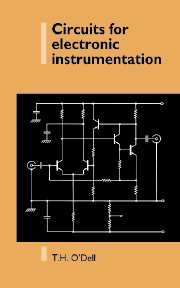Book contents
- Frontmatter
- Contents
- Preface
- 1 Circuits for electronic instrumentation
- 2 Sampling pulse generator circuits
- 3 Sample and hold circuits
- 4 Comparator circuits
- 5 Probes and input circuits
- 6 Wide-band amplifier circuits
- 7 Waveform generator circuits
- 8 Switched capacitor circuits
- 9 Phase locked loop circuits
- 10 Low noise circuits
- Name index
- Subject index
9 - Phase locked loop circuits
Published online by Cambridge University Press: 05 June 2012
- Frontmatter
- Contents
- Preface
- 1 Circuits for electronic instrumentation
- 2 Sampling pulse generator circuits
- 3 Sample and hold circuits
- 4 Comparator circuits
- 5 Probes and input circuits
- 6 Wide-band amplifier circuits
- 7 Waveform generator circuits
- 8 Switched capacitor circuits
- 9 Phase locked loop circuits
- 10 Low noise circuits
- Name index
- Subject index
Summary
Introduction
The phase locked loop (PLL) is used in a number of instrumentation systems. Best's text on PLLs [1] has a chapter on applications in which he lists tracking filters; modulators and demodulators for AM, FM and PM; the recovery of weak signals; frequency synthesis, a field on which there is another valuable text [2]; motor speed control; stereo decoding; subcarrier detection in colour television; and many others.
The original idea of the PLL probably came from the work of de Bellescize in 1932 [3], who used the PLL in AM receiver design. Later work on this application by Tucker and Ridgway provoked a considerable correspondence [4] which suggests that the PLL may be a case of multiple invention, as is so often the case in the field of electronic circuit design.
The simplest kind of PLL is shown in Fig. 9.1. A phase detector is used to give a measure of the phase difference, ϕ, between an incoming signal, v1 sin(ωt) and a VCO. This phase difference is used as an error signal in a closed loop control system in such a way that the VCO ‘locks’ on the incoming signal and follows its changes in phase, and thus in frequency, over some range determined by the designer.
This chapter begins with a very brief look at PLL theory, and this leads at once to an experimental programme using an easily available PLL integrated circuit.
Information
- Type
- Chapter
- Information
- Circuits for Electronic Instrumentation , pp. 159 - 186Publisher: Cambridge University PressPrint publication year: 1991
